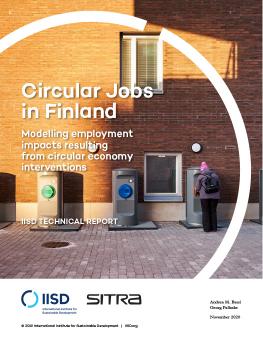
Circular Jobs in Finland
Modelling employment impacts resulting from circular economy interventions
The Circular Economy (CE) assessment explores the outcomes of implementing CE interventions for selected products and sectors in Finland. The areas analyzed include consumer electronics and appliances, textiles, food, mining and scrap metals, forestry and paper production, and buildings. A dynamic simulation model was developed and calibrated to the Finnish context for each of these areas.
Overall, positive employment impacts are forecast for the consumer electronics and forestry sectors, mainly emerging from the high labour intensity of collection, recycling and refurbishing activities. Buildings show net employment creation in the short term, and declines in the medium and longer terms. Negative employment impacts are forecast for all other sectors, largely due to the high contribution of upstream activities to total employment, in the form of primary production of materials (e.g., food, metal ores, textiles), and a reduction of retail jobs resulting from a higher lifetime of products.
Related models are available for download, which can be viewed using software available through Vensim:
- Electronics (.mdl)
- Food (.mdl)
- Forestry (.mdl)
- Mining (.mdl)
- Textiles (.mdl)
Participating experts
You might also be interested in
IISD Joins Global Battery Alliance
IISD is pleased to announce that it has joined the Global Battery Alliance (GBA) as a non-profit member. The GBA is a public–private collaboration platform founded in 2017 at the World Economic Forum to help establish a sustainable battery value chain by 2030.
Is India Ready for an Electric Vehicle Revolution?
IISD's Tom Moerenhout looks at what India needs to do to keep up with countries already embracing the trend toward EVs.
IISD Trade and Sustainability Review, Volume 1, Issue 3, July 2021
From circular economy to environmental cooperation in FTA negotiations, this third edition of the IISD Trade and Sustainability Review covers a range of policy issues from the intersection of trade and sustainable development.
Impacts of Climate Change Policies on Developing Country Export Markets
This report reviews existing net-zero commitments and circular economy plans and assesses the potential impact of core components of such policies on developing country exports.